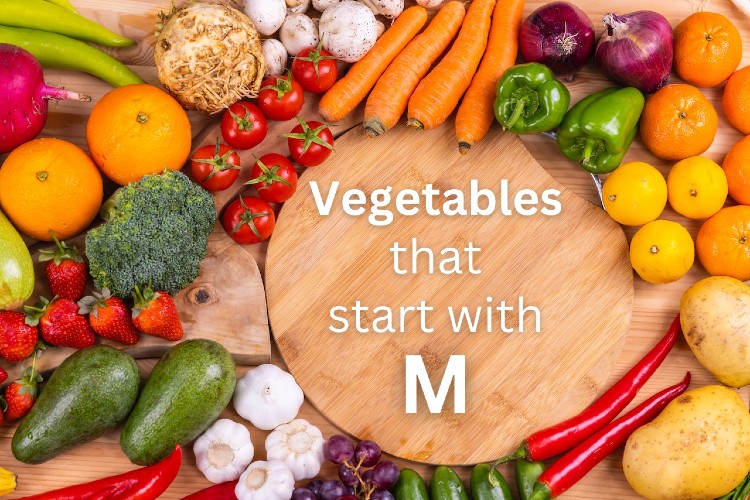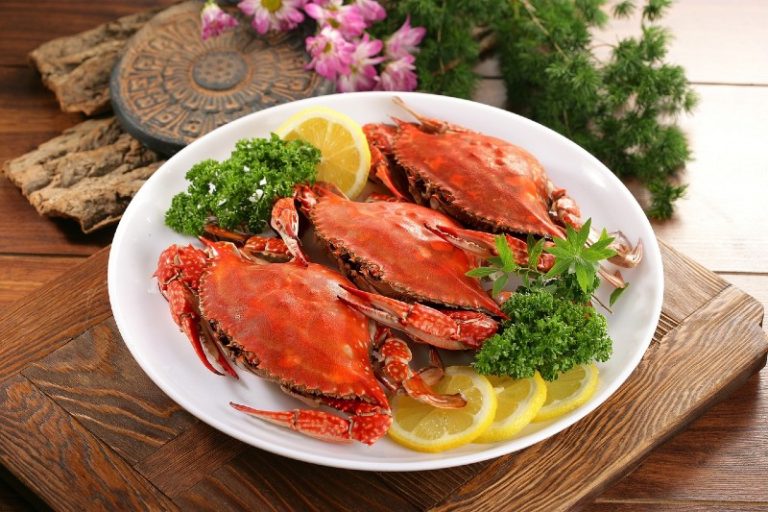Vegetables That Starts with M
Welcome to our comprehensive list of vegetables that start with the letter M!
Whether you’re seeking mushroom or mizuna, we’ve got you covered with a collection of amazing veggies.
Our list includes a variety of vegetables starting with M, and we’ve provided detailed information, along with links to recipes, so you can explore and enjoy these vegetables to the fullest.
But wait, there’s more! If you happen to know of any other vegetables that start with M that we might have missed, we would love to hear from you. Leave a comment, and we’ll gladly add them to our list of veggies beginning with M.
Get ready to discover and savor a wide range of delicious vegetables that all share a common trait – their names start with the letter M!
Vegetables Beginning With M
Here is the list of vegetables starting with M.
- Malabar Spinach
- Malanga
- Mallow
- Mangetout
- Marrow
- Methi
- Miatake
- Microgreens
- Mizuna
- Mung Beans
- Mushrooms
- Mustard Greens
- Mooli
- Mulukhiyah
- Manoa
- Mashua
- Morel Mushrooms
- Moth Bean
- Mozuku
Details of Vegetables Starting with Letter M
Malabar Spinach
Malabar spinach is a leafy green vegetable popular in Indian and Southeast Asian cuisines. It has thick, fleshy leaves with a mild, slightly tangy flavor.
Malabar spinach is commonly used in stir-fries, curries, and soups. It can also be eaten raw in salads or used as a substitute for spinach in recipes.
This vegetable is a good source of vitamins A and C, iron, and calcium. Malabar spinach is appreciated for its versatility, as well as its heat tolerance and ability to thrive in hot climates.
Malanga
Malanga, also known as taro root or dasheen, is a starchy tuber widely used in Caribbean, African, and Asian cuisines. It has a brown, hairy exterior and a white or purple flesh.
Malanga is typically boiled, steamed, or fried and used in dishes like stews, fritters, and chips. It has a nutty flavor and a creamy texture when cooked.
Malanga is a good source of dietary fiber, vitamins, and minerals. It is appreciated for its versatility, providing a gluten-free alternative to potatoes and other root vegetables.
Mallow
Mallow, also known as common mallow or Malva, is an edible plant that has been used as a medicinal herb and a food source for centuries.
It has rounded leaves and delicate flowers. Mallow leaves are often cooked and used in soups, stews, and sautés.
They have a mild, slightly tangy taste. Mallow leaves are a good source of vitamins A and C, as well as dietary fiber. They are known for their mucilaginous properties, which can add a thickening texture to dishes.
Mangetout
Mangetout, also known as snow peas, are a type of edible podded peas that are harvested before the peas inside fully develop. They have tender, flat pods and a sweet flavor.
Mangetout peas are commonly used in stir-fries, salads, and Asian-inspired dishes. They can be eaten raw or lightly cooked.
Mangetout peas are a good source of vitamins A and C, as well as dietary fiber. They are appreciated for their crisp texture, refreshing taste, and their ability to add a vibrant element to dishes.
Marrow
Marrow is a vegetable belonging to the same family as zucchini and squash. It has a similar appearance to zucchini but is generally larger in size.
Marrow has a mild, slightly sweet flavor and a soft, creamy texture.
It can be roasted, grilled, stuffed, or used in soups and stews. Marrow is a versatile vegetable that can be prepared in various ways.
It is a good source of dietary fiber, vitamins A and C, and potassium. Marrow is appreciated for its delicate taste and its contribution to seasonal recipes.
Methi
Methi, also known as fenugreek, is an herb commonly used in Indian, Middle Eastern, and North African cuisines. It has small, green leaves and a distinctive aroma.
Methi leaves and seeds are used in a variety of dishes, including curries, bread, and spice blends. They add a slightly bitter, nutty flavor to recipes.
Methi is known for its medicinal properties and is believed to have various health benefits.
It is rich in vitamins, minerals, and antioxidants. Methi leaves and seeds are valued for their unique flavor profile and their contribution to the complexity of spice blends and traditional dishes.
Miatake
Maitake mushrooms, also known as hen-of-the-woods, are a type of edible mushroom that grows in clusters with layered, frilly caps. They have a rich, earthy flavor and a firm texture.
Maitake mushrooms are highly regarded in Japanese cuisine and are used in soups, stir-fries, and noodle dishes.
They can also be grilled or roasted as a side dish or added to sauces and gravies.
Maitake mushrooms are known for their nutritional content, including vitamins B and D, minerals, and antioxidants. People love them for their unique appearance, meaty texture, and umami flavor.
Microgreens
Microgreens are young, tender greens that are harvested at an early stage of growth, typically when they have developed their first set of true leaves. They come in a variety of flavors and textures, ranging from peppery to nutty.
Microgreens are often used as garnishes or added to salads, sandwiches, and soups to enhance both the visual appeal and the taste of dishes.
They are known for their high nutritional content, including vitamins, minerals, and antioxidants.
Microgreens are appreciated for their delicate and concentrated flavors, as well as their ability to provide a nutrient-packed boost to meals.
Mizuna
Mizuna is a leafy green vegetable commonly used in Japanese cuisine. It has feathery, deeply cut leaves and a slightly spicy, mustard-like flavor.
Mizuna is often eaten raw in salads or used as a garnish for soups and stir-fries. It can also be lightly sautéed or steamed.
Mizuna is a good source of vitamins A, C, and K, as well as folate and dietary fiber.
People love it for its peppery taste, its attractive appearance, and its versatility in both Asian and Western culinary preparations.
Mung Beans
Mung beans are small, green legumes that are commonly used in Asian cuisines. They have a mild, nutty flavor and a soft, creamy texture when cooked.
Mung beans are often sprouted and used in salads, stir-fries, and soups. They can also be ground into flour or used to make bean paste for desserts.
Mung beans are a good source of plant-based protein, dietary fiber, and essential nutrients such as folate and magnesium.
They are appreciated for their versatility, quick cooking time, and their contribution to both savory and sweet dishes.
Mushrooms
Mushrooms are a diverse group of fungi that come in various shapes, sizes, and flavors. They are highly versatile and used in cuisines around the world. Mushrooms can be cultivated or foraged, and each variety has its unique characteristics.
They can be enjoyed raw in salads, sautéed, grilled, roasted, or used as a meat substitute in vegetarian and vegan dishes.
Mushrooms are low in calories and fat and are a good source of vitamins, minerals, and antioxidants.
They are valued for their umami flavor, meaty texture, and their ability to add depth and richness to a wide range of recipes.
Mustard Greens
Mustard greens are leafy green vegetables with a slightly spicy and peppery flavor. They are commonly used in Southern American, Indian, and African cuisines.
Mustard greens can be cooked, sautéed, or added to soups and stews. They can also be used in salads and smoothies.
Mustard greens are a good source of vitamins A, C, and K, as well as calcium and dietary fiber. They are appreciated for their bold flavor, nutritional value, and their ability to add a lively kick to dishes.
Mooli
Mooli, also known as daikon radish, is a large, white radish commonly used in Asian cuisines, particularly in Japanese, Chinese, and Korean dishes. It has a crisp texture and a mildly spicy flavor.
Mooli can be eaten raw in salads, pickled, or cooked in stir-fries, soups, and stews. It is a versatile vegetable that adds a refreshing crunch to dishes.
Mooli is a good source of vitamin C, potassium, and dietary fiber. It is appreciated for its distinct taste, ability to absorb flavors, and its contribution to both hot and cold Asian recipes.
Mulukhiyah
Mulukhiyah, also known as jute mallow, is a leafy green vegetable commonly used in Middle Eastern and African cuisines.
It has a slightly slimy texture when cooked and a unique flavor that is often described as earthy and spinach-like.
Mulukhiyah leaves are typically cooked and used in soups, stews, and sautés. They are often paired with meat or chicken and served over rice or with bread.
Mulukhiyah is a good source of vitamins A and C, iron, and calcium. It is appreciated for its nutritional value, distinctive taste, and its cultural significance in regional cuisines.
Manoa
Manoa lettuce is a type of leafy green vegetable with tender leaves and a mild, slightly sweet flavor. It is commonly used in salads and sandwiches, as well as in wraps and tacos.
Manoa lettuce has a crisp texture and pairs well with a variety of dressings and toppings. It is a good source of vitamins A and K, as well as dietary fiber.
It is famous for its delicate taste, versatility, and its contribution to refreshing and nutritious salads.
Mashua
Mashua, also known as Peruvian ground apple, is a tuberous root vegetable native to the Andean region of South America. It has a crisp texture and a spicy, peppery flavor.
Mashua can be cooked and used in stews, stir-fries, and roasted dishes. It can also be sliced and eaten raw in salads or pickled.
It is known for its unique taste, vibrant color, and its adaptability to different cooking methods.
Mashua is rich in vitamins, minerals, and antioxidants, and is considered a traditional crop in the Andean cuisine.
Morel Mushrooms
Morel mushrooms are highly prized for their distinct appearance and rich, earthy flavor. They have a cone-shaped cap with a honeycomb-like texture.
Morel mushrooms are commonly foraged and used in gourmet cooking. They can be sautéed, stuffed, added to sauces, or used in risottos and pasta dishes.
Morel mushrooms have a unique taste and aroma that is difficult to replicate with other mushrooms. They are appreciated by mushroom enthusiasts and chefs for their culinary value and their seasonal availability.
Moth Bean
Moth beans, also known as matki beans or dew beans, are small, oval-shaped legumes commonly used in Indian cuisine. They have a nutty flavor and a firm texture.
Moth beans are often sprouted or cooked and used in curries, stews, and dal (lentil) dishes. They can also be ground into flour to make snacks and flatbreads.
Moth beans are a good source of protein, dietary fiber, and essential nutrients. They are appreciated for their versatility, nutritional profile, and their contribution to vegetarian and vegan recipes.
Mozuku
Mozuku is a type of edible seaweed that is highly valued in Japanese cuisine. It has long, thin strands and a slightly slimy texture.
Mozuku is commonly used in salads, soups, and as a topping for rice and noodles. It has a delicate, subtly sweet flavor.
Mozuku seaweed is rich in minerals and dietary fiber, making it a nutritious ingredient. It is appreciated for its unique texture, taste, and its contribution to the umami flavors in Japanese dishes.
That concludes our list of “Vegetables that start with M“! We hope you found it informative and helpful for your culinary endeavors.
We value your input! If you think there are any vegetables beginning with M that is missing in above list, please let us know in the comments section below.





